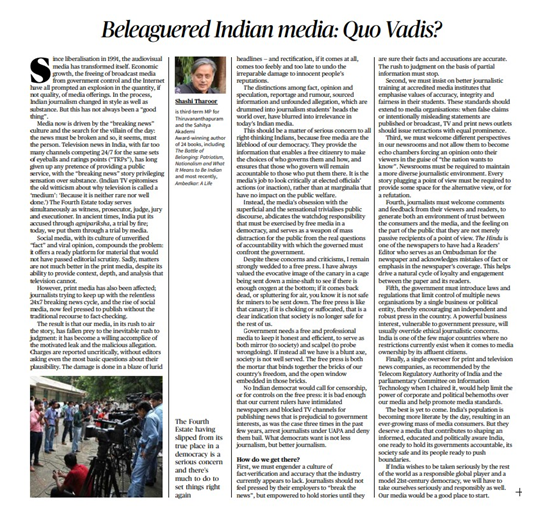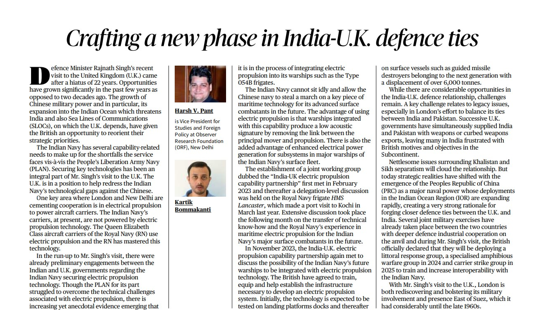Transformation of Audiovisual Media since 1991
Transformation of Audiovisual Media since 1991:
▪ Liberalization in 1991 sparked significant changes in the Indian
audiovisual media landscape.
▪ Economic growth, liberation from government control, and the rise of
the Internet led to a proliferation of media offerings.
▪ Quality has not always matched quantity, with changes in both style
and substance of Indian journalism.
2. Impact of “Breaking News” Culture:
▪ Media is now driven by a “breaking news” culture, prioritizing
sensationalism over substance.
▪ TV news, competing intensely for viewership, has abandoned the
public service role.
▪ The Fourth Estate acts as witness, prosecutor, judge, jury, and
executioner, contributing to a trial by media.
3. Blurring Lines in Journalism Ethics:
▪ Distinctions among fact, opinion, speculation, reportage, and rumor
have blurred in Indian media.
▪ Social media, with its unverified information and viral opinions,
exacerbates the problem.
▪ Print media, despite its potential for depth, analysis, and context, faces
challenges in fact-checking due to the 24/7 news cycle
4. Concerns about Media’s Role in Democracy:
▪ Media’s obsession with superficial and sensational content trivializes
public discourse.
▪ The media’s failure to fulfill its watchdog responsibility distracts the
public from real questions of accountability.
▪ Despite concerns, the author advocates for a free press as a vital
component of democracy.
5. Solutions for Better Journalism:
▪ Encourage a culture of fact-verification and accuracy, discouraging the
rush to break news without thorough checks.
▪ Emphasize better journalistic training at accredited institutes with a
focus on values of accuracy, integrity, and fairness.
▪ Promote diverse perspectives in newsrooms to prevent echo
chambers and encourage balanced reporting.
EDITORIAL ANALYSIS WWW.STATECRAFT.IN
▪ Foster communication and feedback between journalists and the
audience to build trust and engagement.
▪ Advocate for laws limiting control of multiple news organizations by a
single entity to ensure an independent and robust press.
6. Government’s Role in Media Standards:
▪ Introduce laws and regulations limiting the control of news
organizations by a single business or political entity.
▪ Consider a single overseer for print and television news companies to
curb the influence of corporate and political entities.
▪ Government interventions should promote an independent and ethical
press
7. Optimism for the Future:
▪ Despite challenges, the author remains optimistic about the future of
Indian media.
▪ The growing literacy rate and media consumers deserve an informed,
educated, and politically aware media landscape.
▪ A responsible and accountable media is crucial for India to be
perceived as a global player and a model 21st-century democracy.
1. Background and Significance of the Visit:
▪ Rajnath Singh’s recent visit to the U.K. marked a significant event after
a hiatus of 22 years.
▪ Opportunities for collaboration have increased, driven by the growth
of Chinese military power, particularly its expansion into the Indian
Ocean.
2. Strategic Reorientation of the U.K.:
▪ The threat posed by Chinese military activities in the Indian Ocean has
prompted the U.K. to reassess its strategic priorities.
▪ The Sea Lines of Communications (SLOCs) that the U.K.
depends on are under threat, creating an opportunity for strategic
alignment with India.
3. Indian Navy’s Capability Needs:
▪ The Indian Navy faces capability shortfalls compared to the People’s
Liberation Army Navy (PLAN).
▪ Defence Minister Rajnath Singh’s visit focuses on securing key
technologies to address these shortfalls.
4. Cooperation in Electrical Propulsion:
▪ Collaboration between London and New Delhi includes addressing
technological gaps in electrical propulsion for aircraft carriers.
▪ The Royal Navy’s expertise in electric propulsion technology is being
leveraged to enhance the Indian Navy’s capabilities.
5. Advantages of Electric Propulsion:
▪ Electric propulsion technology provides a low acoustic signature, a
crucial advantage in naval warfare.
▪ Enhanced electrical power generation for subsystems in major
warships is another benefit.
5. Advantages of Electric Propulsion:
▪ Electric propulsion technology provides a low acoustic signature, a
crucial advantage in naval warfare.
▪ Enhanced electrical power generation for subsystems in major
warships is another benefit.
6. Establishment of Joint Working Group:
▪ The “India-UK electric propulsion capability partnership” was formed
in February 2023.
▪ Delegations discussed technical know-how transfer and experiences
related to maritime electric propulsion
7. Timeline of Partnership Development:
▪ Preliminary engagements occurred before Rajnath Singh’s visit, with a
delegation-level discussion on HMS Lancaster in March.
▪ The partnership progressed through extensive discussions, with plans
for technology testing on landing platforms docks and guided missile
destroyers.
8. Challenges in India-UK Defence Relationship:
▪ Legacy issues, including London’s balancing act between India and
Pakistan, pose challenges.
EDITORIAL ANALYSIS WWW.STATECRAFT.IN
▪ Concerns related to Khalistan and Sikh separatism may impact the
relationship.
9. Shifting Strategic Realities:
▪ Despite challenges, strategic realities, especially the rise of China as a
major naval power, necessitate closer defence ties between the U.K.
and India.
▪ Joint military exercises, deeper defence industrial cooperation, and
upcoming deployments underline the strengthening partnership.
10. Rediscovery of Military Involvement East of Suez:
▪ Rajnath Singh’s visit signifies the U.K.’s rediscovery and bolstering of
military involvement and presence East of Suez, aligning with historical
engagements until the late 1960s.



